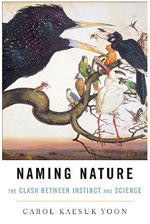
Naming Nature: The Clash Between Instinct and Science
by Carol Kaesuk Yoon
–Reviewed by Jodie Liu
 When Carol Yoon became a biologist, she prepared herself to see for the first time “a truly scientific ordering of life.” As is the case with many scientists, it never occurred to Yoon to doubt the supremacy of science. But years later, as she dug deeper into the complexities of taxonomy, Yoon discovered that science sometimes fails to provide unquestionable truths when it comes to the task of naming nature. Her ensuing struggle – to understand taxonomy from the perspective of both science and human instinct – led Yoon to question her scientific view of the world. Naming Nature is the result of that sophisticated exploration.
When Carol Yoon became a biologist, she prepared herself to see for the first time “a truly scientific ordering of life.” As is the case with many scientists, it never occurred to Yoon to doubt the supremacy of science. But years later, as she dug deeper into the complexities of taxonomy, Yoon discovered that science sometimes fails to provide unquestionable truths when it comes to the task of naming nature. Her ensuing struggle – to understand taxonomy from the perspective of both science and human instinct – led Yoon to question her scientific view of the world. Naming Nature is the result of that sophisticated exploration.
Despite her scientific subject matter, Yoon is chipping away at something deeper and more mysterious: human cognition. At the core of human nature, Yoon claims, is a thing called umwelt, an intricate yet simple and universal explanation for how humans view the world and why we seek to name the things in it. “It is the umwelt,” Yoon explains, “that gives us our stereotyped, hard-wired way of perceiving the order in living things.” That is to say, we strive to order our world in a way that is instinctual, understandable, and uniquely human.
Horticultural prodigy Carl Linnaeus was the first taxonomist to try to arrange the world according to his gut. In the first edition of his Systema Naturae, Linnaeus presented an ordering of all living things that was based upon his own “inarticulable sense of things.” With one bold move, Linnaeus had “validated the ancient notion that life should be ordered based entirely upon one’s individual perceptions,” a notion that persisted in taxonomy for centuries. Linnaeus’ instinctual search for “one single, perfect, true natural order” of the world’s organisms is a desire that Yoon argues can be explained by the umwelt. A belief in “one solution to the puzzle of the living world, one and only one correct path out of its chaotic labyrinth” is part of the human compulsion to order the objects and organisms of our surroundings.
But even with Linnaeus’ numerous triumphs in taxonomy, there were always exceptions to his rules, evolutionary deviations from the norm, that couldn’t be classified without raising contentions. Here, Yoon suggests, is where the umwelt proved fallible: once a method was constructed to find a truly perfect order, things began to defy that order. Numerical taxonomy, developed by Robert Sokal and Peter Sneath, solved the quandaries of taxonomy by creating a system of codifying organisms by their features and calculating percentages of similarity between specimens. It was a foolproof system, Yoon explains, but it also spelled the end of the umwelt perception of nature. Gone was Linnaeus’ “luxuriant and sensuous view of life.” In its place, Sokal and Sneath glorified numerical taxonomy’s “objectivity, repeatability, quantification, and explicit and explicable methods.” The farther we ventured towards a flawless numerical science, Yoon observes, the farther we distanced ourselves from the human understanding of nature and all living things.
Yoon argues that today, our umwelt is still present, but in modified form. Few of us have the desire much less the ability to identify different species of reptiles, but who can’t recognize the golden arches of McDonald’s, the Nike swoosh, or the Macintosh apple? We’ve traded in our familiarity with stealthy jaguars in the rainforest for the shiny Jaguars at automobile dealerships. “Here we sit, with our merchandise-clogged umwelts, smack dab in the middle of the sixth great mass extinction of life on earth,” Yoon writes, “there are so many reasons we’ve been able to reach this point, this biodiversity crisis, and a couple trace right back to the umwelt.”
It is a situation that Yoon laments, but not one that is unconquerable. There is a dynamic world beyond our name brands and product logos, Yoon insists, one that is pulsating with life and nature, and it is ours to take in if only we are willing to reclaim it.
Excerpt: Unlike the other modern sciences – the other branches of biology, chemistry, and physics – taxonomy was born not as a scholarly endeavor, not as an intellectual pursuit, but as a human predilection, a hard-wired and ageless tradition. In contrast, we have no inner umwelt that chafes against the science of chemistry. Alchemists wished and believed that they could turn lead into gold, but today there are precious few among us who fail to accept that we cannot. Physics (at least Newtonian physics) likewise insists on nothing that we take issue with. We have a sense of how things should move in space and Newton’s portrayal is consistent with that sense. Even when Einstein and others began fiddling with ideas that made our heads hurt, we could still accept them. For as non-intuitive as quantum mechanics and the behavior of subatomic particles might be, we have no expectation that we should be able to intuit or understand it, no sense of how subatomic particles should act with which their work conflicts.
All the other scientists were free to go about their experimenting and hypothesizing in a thoroughly modern, logical, and rational way. But evolutionary taxonomists – also simply trying to do their work, trying to make a living as professionals and prove their mettle alongside the big boys in physics and genetics – were burdened with a potent umwelt, gray matter more than ready to order and name life to its taste, built for an instant understanding of a tiny sliver of earth’s immutable bounty.
Perhaps we should pity evolutionary taxonomists all the more because, though they did not know it, they were being asked to do something never before done – to depart from what was in reality an ancient human quest, the journey to use our umwelt to articulate the natural order around us.
Further Reading: Nature and the Human Soul: Cultivating Wholeness and Community in a Fragmented World and Linnaeus’ Philosophia Botanica
*Photo courtesy Mike Baird.




Send A Letter To the Editors